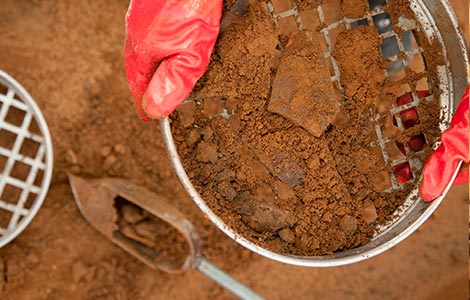
- Boron deficiencies in crops are found mainly in low organic matter soils and in acid, sandy soils in humid regions.
- Organic matter is the storehouse for most of the available boron (B) in soils.
- Boron deficiencies frequently are associated with drought periods, because root activity decreases in the surface soil layer.
- Balanced soil fertility, which gives improved plant vigor and root growth, results in optimum uptake of B and other plant nutrients.
Reactions in soils which can affect boron’s availability to plants vary significantly. The main soil factors affecting boron availability are as follows:
Soil organic matter
Most of the available boron in soils is found in soil organic matter. Organic matter complexes with boron to remove it from soil solution when levels are high after boron fertilization. Soil organic matter decomposes to resupply the soil solution to maintain adequate boron levels when solution boron is removed by crop uptake or leaching. Soils with low organic matter content have reduced boron-supplying capacity and will usually require more frequent boron fertilization at lower application rates. Soil organic matter must be decomposed to release complexed boron, so conditions such as cool, wet weather or hot, dry weather which decrease organic matter breakdown will reduce available boron in soils.
Soil texture
Sandy soils that are well drained are most likely to be boron deficient in high rainfall situations because of their greater leaching potential. These soils may need more frequent boron fertilization. However, if subsoils are fine textured (higher clay content) below sandy surface horizons, less frequent boron applications may be needed. Total boron is usually highest in clay soils, but plant availability may be low in these soils because of the strength by which boron is held on the clay surfaces.
Soil pH and liming
Boron availability to plants decreases with increasing soil pH, especially above pH 6.5. However, strongly acid soils (pH less than 5.0) also tend to be low in available boron because of boron sorption to iron and aluminum oxide surfaces of soil minerals. Some crops with a high demand for boron—such as alfalfa—also require a soil pH above 6.5 for optimum growth, so liming may be necessary. However, overliming acid soils often has resulted in temporary boron deficiencies, especially when liming to pH levels above 7.0.
Soil microbial activity
Microorganisms break down soil organic matter, so plant-available boron is released from organic complexes. Conditions favoring improved microbial activity are warm, moist soils with adequate aeration. Soil conditions which hinder optimum microbial activity are drought conditions, cold and wet soils, and poor soil tilth (poor aeration).
Soil fertility
Balanced soil fertility generally results in improved boron uptake by plants. The resulting improved plant vigor and root growth allows greater uptake of boron and other nutrients. This is why soil test results should be carefully examined and nutrients which are marginal or deficient should be applied at recommended rates.
Drought conditions
During periods of drought, the topsoil dries out so plant roots are unable to feed in the uppermost soil layer where most of the available boron occurs. Dry weather also limits the availability of B because it restricts water flow, which transports available B in solution. Crops are more likely to become boron deficient during drought periods in soils with low levels of available boron.
Tillage
Boron is more available to plant roots when the surface soil is tilled. Tillage allows soil mixing and improves aeration and drainage. These conditions are optimum for organic matter breakdown, which releases available boron. As crop production systems shift to reduced tillage or no-till management, organic matter will accumulate on or near the soil surface and may not break down rapidly. Boron availability then will become more dependent on surface moisture conditions, and fertilizer management may become more crucial.
Summary
Boron deficiencies are found mainly on soils which are low in organic matter, and also on acid, sandy soils especially in humid regions where leaching can occur. An understanding of boron reactions in soil will assist in predicting where boron deficiencies are most likely to occur. Results of soil tests for available boron will give the boron status of soils in a particular field. Recommended boron rates should be applied if available boron levels are low or marginal, especially for crops with a high-boron requirement, such as alfalfa.
Download Agronomy Notes